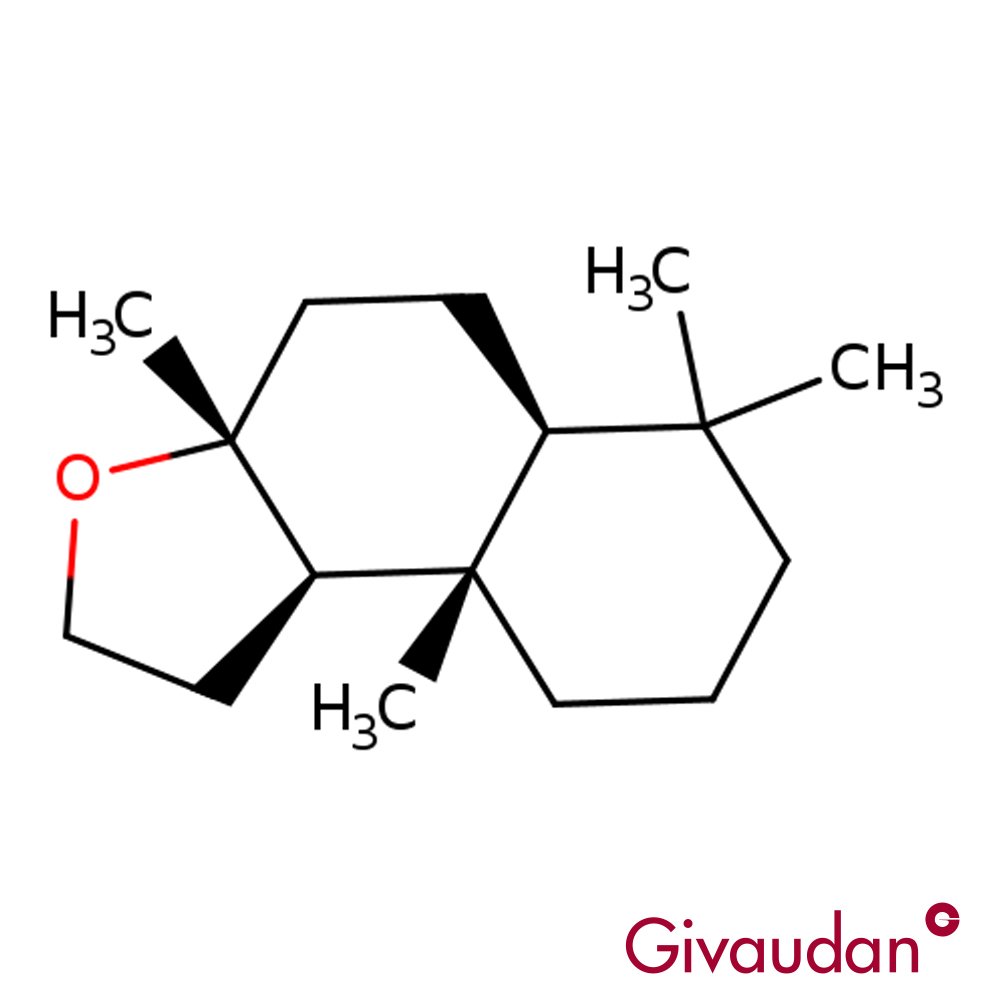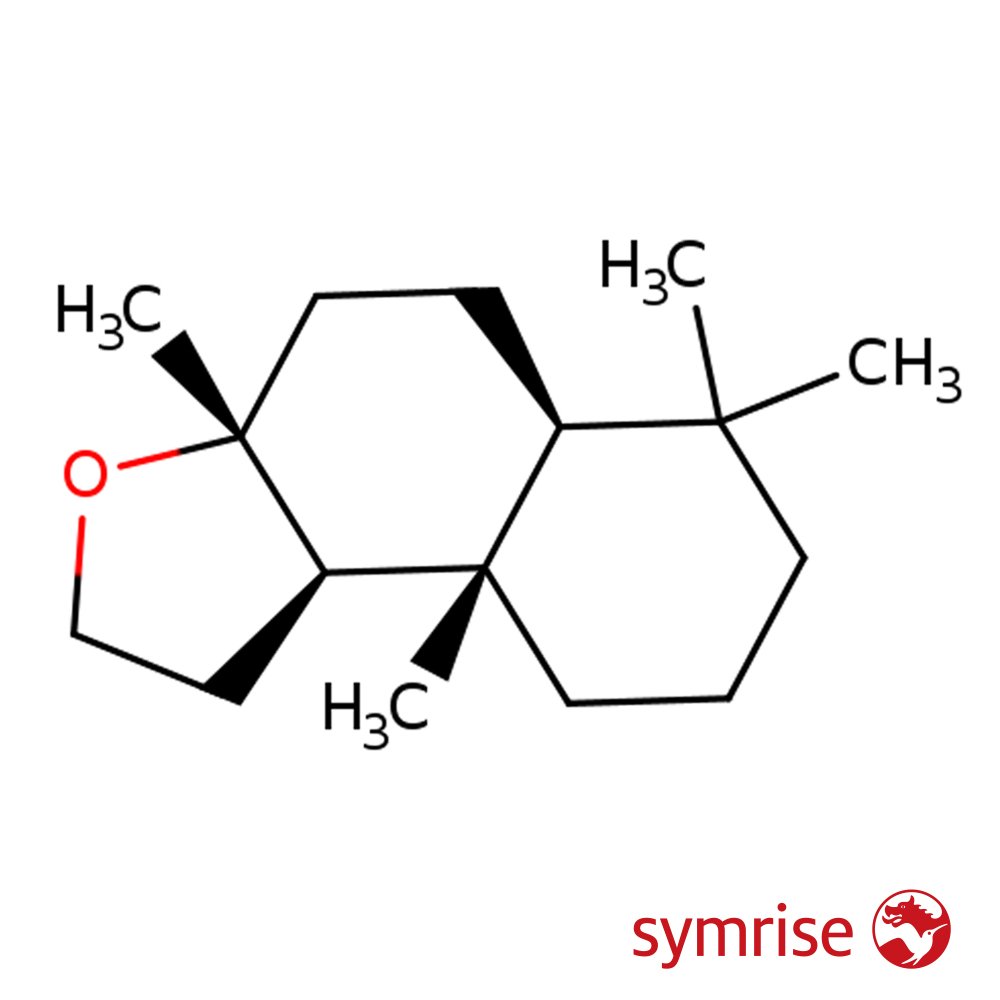Ambrofix ®
Premium Synthetic Ingredient for Perfumery
Ambrofix® is a biotechnologically derived synthetic aroma chemical developed by Givaudan. It replicates the structure and olfactory performance of Ambroxan, offering a warm ambergris scent profile with woody-musky nuances.
Produced from sugarcane-derived feedstocks via fermentation, it serves as a powerful fixative and base material in perfumery with high tenacity and excellent stability under diverse formulation conditions.
Premium Synthetic Ingredient for Perfumery
Ambrofix® is a biotechnologically derived synthetic aroma chemical developed by Givaudan. It replicates the structure and olfactory performance of Ambroxan, offering a warm ambergris scent profile with woody-musky nuances.
Produced from sugarcane-derived feedstocks via fermentation, it serves as a powerful fixative and base material in perfumery with high tenacity and excellent stability under diverse formulation conditions.
Premium Synthetic Ingredient for Perfumery
Ambrofix® is a biotechnologically derived synthetic aroma chemical developed by Givaudan. It replicates the structure and olfactory performance of Ambroxan, offering a warm ambergris scent profile with woody-musky nuances.
Produced from sugarcane-derived feedstocks via fermentation, it serves as a powerful fixative and base material in perfumery with high tenacity and excellent stability under diverse formulation conditions.
Technical Ingredient Overview
🏭 Manufacturer — Givaudan
🔎 Chemical Name — (1R,3R,5R,7R,8S)-1,8,8-trimethyl-2-oxa-4-oxobicyclo[3.3.1]nonane
🧪 Synonyms — Ambroxan, Ambroxide, Ambrox®, Ambrofix®
🧬 Chemical Formula — C₁₆H₂₈O
📂 CAS — 6790-58-5 / 3738-00-9
📘 FEMA — 3434
⚖️ MW — 236.39 g/mol
📝 Odor Type — Ambergris, woody, musky
📈 Odor Strength — Medium to strong
👃🏼 Odor Profile — Warm ambergris, dry woody, musky, slightly animalic, creamy, radiant
⚗️ Uses — Fine fragrance, functional perfumery, hair & skin care, fabric care
🧴 Appearance — White crystalline solid or flakes
What is Ambrofix®?
Ambrofix® is Givaudan’s trademarked, 100% renewable and biotechnologically derived form of Ambroxide, one of the most important modern ambergris-type aroma chemicals. It replicates the iconic structure of Ambroxan, yet it is produced via fermentation of sugarcane-derived feedstocks, offering a carbon-efficient alternative to traditional synthetic or semisynthetic methods. It provides high olfactory performance, extreme stability, and powerful substantivity.
Historical Background
The origin of Ambroxide-based compounds dates back to the 1950s, when Firmenich first developed Ambrox® from sclareol, a diterpene extracted from Clary Sage (Salvia sclarea) (Sell, 2014). Over the decades, Ambroxan became an indispensable material in perfumery for recreating the scent of ambergris, a rare natural secretion from the sperm whale (Physeter macrocephalus).
In 2021, Givaudan launched Ambrofix®, applying green chemistry principles and leveraging biotechnology to obtain the molecule from 100% renewable carbon. This approach drastically reduces environmental impact while maintaining identical olfactory and physicochemical performance (Givaudan, 2021).
Olfactory Profile
Scent Family: Woody-Amber
Main Descriptors: Ambergris, dry wood, musky, smooth, clean, radiant
Intensity & Tenacity: Medium to high strength; outstanding longevity on skin and fabric
Volatility: Low
Fixative Role: Excellent fixative with high substantivity and radiance in the base notes
Applications in Fine Fragrance
Ambrofix® is a pillar material in modern perfumery. It serves as:
A signature ambergris substitute in amber, fougère, musky, and woody compositions
A fixative and radiance booster for florals, orientals, and aquatics
A background enhancer for iso E super-rich or musk-forward accords
Notable perfumes (using Ambroxan or Ambrofix® analogs):
Escentric Molecules 02 (Geza Schoen)
Juliette Has a Gun — Not a Perfume
Maison Francis Kurkdjian — Baccarat Rouge 540
Performance in Formula
Ambrofix® exhibits:
High diffusivity even at low doses (0.5–5%)
Exceptional stability across pH ranges, light, oxidation, and temperature
Compatibility with a wide range of materials including musks, lactones, and aldehydes
Excellent retention in textiles and skin adhesion, especially in long-wear formats
Industrial & Technical Uses
In addition to fine fragrance, Ambrofix® is widely applied in:
Functional perfumery: long-lasting notes in detergents, shampoos, and deodorants
Fabric care: enhances freshness and scent retention in laundry formulations
Personal care: provides creamy amber musky warmth in body lotions and hair care
Home care: adds smooth woody undertones in candles and air fresheners
Regulatory & Safety Overview
IFRA Compliance: Allowed for use under the current IFRA 51st Amendment; no specific restrictions
GHS Classification: Not classified as hazardous under GHS
EU Cosmetics Regulation: Permitted; no labeling required under allergen declaration
Toxicology: Low toxicity; non-sensitizing and non-phototoxic in standard assays (RIFM, 2020)
REACH Registered
FEMA GRAS — FEMA No. 3434, approved for flavor use (though rarely applied in flavoring)
Additional Information
Sustainability Note:
According to Givaudan’s LCA, Ambrofix® reduces carbon footprint by up to 99% compared to traditional Ambrox® production. It is readily biodegradable, manufactured in a water-efficient bioprocess, and meets the standards of green chemistry and sustainable sourcing.
INCI (for cosmetic use): Ambroxide
References
Givaudan. (2021). Ambrofix: Sustainable biotechnology-based Ambrox. Retrieved from https://www.givaudan.com
Sell, C. S. (2014). The Chemistry of Fragrances (2nd ed.). Royal Society of Chemistry.
Arctander, S. (1960). Perfume and Flavor Chemicals (Aroma Chemicals).
Research Institute for Fragrance Materials (RIFM). (2020). Safety Assessment for Ambroxide.
PubChem. (n.d.). Ambroxide (CID 10733). National Institutes of Health.
FEMA. (n.d.). Flavor and Extract Manufacturers Association — FEMA No. 3434.






